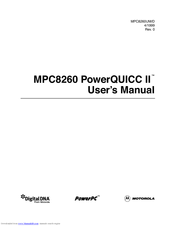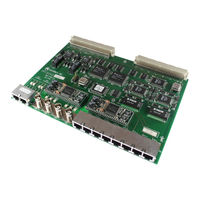Motorola MPC8260 PowerQUICC II Manuals
Manuals and User Guides for Motorola MPC8260 PowerQUICC II. We have 2 Motorola MPC8260 PowerQUICC II manuals available for free PDF download: User Manual
Motorola MPC8260 PowerQUICC II User Manual (1006 pages)
Motorola Processor Users Manual
Brand: Motorola
|
Category: Computer Hardware
|
Size: 10 MB
Table of Contents
-
Features37
-
Audience55
-
Organization56
-
Conventions60
-
-
Features71
-
Mpc603E Core75
-
Signals77
-
Basic System85
-
-
-
Overview89
-
Cache Units96
-
Register Set96
-
Data Cache107
-
Cache Locking109
-
Way Locking109
-
Exception Model110
-
-
-
Bus Monitor141
-
Timers Clock142
-
Reset Causes185
-
Reset Actions186
-
HRESET Flow187
-
SRESET Flow187
-
-
External Signals203
-
Chapter 7
217-
Bus Grant (BG)218
-
Global (GBL)223
-
-
Terminology233
-
Pipeline Control258
-
TLBISYNC Input265
-
-
-
Clock Unit267
-
Main PLL271
-
Skew Elimination272
-
Clock Dividers272
-
PLL Pins273
-
-
-
Features279
-
Data Pipelining286
-
SDRAM Machine309
-
ACTIVATE Command315
-
SDRAM Refresh323
-
Relaxed Timing331
-
Requests340
-
Clock Timing343
-
The RAM Array345
-
RAM Words346
-
Loop Control352
-
Signals Negation354
-
Wait States371
-
-
-
Features431
-
Features434
-
CP Block Diagram434
-
Command Set441
-
CP Commands443
-
Dual-Port RAM445
-
Parameter RAM447
-
Features457
-
Overview458
-
SCIT Programming487
-
-
-
Features492
-
CMX Registers496
-
-
Chapter 17
516 -
-
SDMA Registers527
-
IDMA Emulation529
-
IDMA Features529
-
IDMA Transfers530
-
Normal Mode533
-
IDMA Priorities536
-
Dreqx and Dackx537
-
Donex538
-
IDMA Operation538
-
IDMA Performance546
-
IDMA Bds547
-
IDMA Commands550
-
-
Features558
-
Saving Power583
-
-
-
Features586
-
Synchronous Mode587
-
-
-
Delayed RTS Mode629
-
-
Features634
-
-
-
Features653
-
-
-
Features671
-
-
Features698
-
Saving Power706
-
SMC in UART Mode706
-
Features707
-
Sending a Break709
-
SMC UART Rxbd710
-
SMC UART Txbd712
-
Features717
-
SMC GCI Commands728
-
-
-
Features731
-
MCC Commands746
-
MCC Exceptions747
-
Advertisement
Motorola MPC8260 PowerQUICC II User Manual (112 pages)
ADS
Brand: Motorola
|
Category: Computer Hardware
|
Size: 0 MB
Table of Contents
-
ADS Features10
-
Introduction13
-
Introduction23
-
GND Bridges26
-
Memory Map28
-
Bus Mode38
-
Buffering38
-
ATM Port47
-
RS232 Ports47

